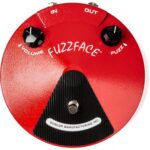
In the ever-evolving landscape of music, there exists a sonic innovation that has transformed the guitar’s tonal palette – the fuzz guitar effect. This peculiar sound alteration has left an indelible mark on music history, captivating the ears of listeners and empowering musicians with an entirely new realm of sonic possibilities.
The Genesis of Fuzz: Invention and Evolution
The birth of fuzz can be traced back to the early 1960s when a malfunction in recording equipment unintentionally produced a distorted sound. This ‘accident’ sparked the curiosity of musicians and engineers, prompting them to replicate and harness this distinctive sonic texture deliberately.
The first commercially available fuzz pedal, the Maestro FZ-1 Fuzz-Tone, emerged in 1962. Its invention is often attributed to Orville “Red” Rhodes and Glen Snoddy. The Beatles’ iconic use of the Fuzz-Tone in their song “I Feel Fine” catapulted the effect into the limelight, sparking a frenzy of experimentation among guitarists.
Pioneers and Usage
The widespread adoption of fuzz effects in the 1960s and ’70s saw guitar legends embracing this new sonic frontier. Jimi Hendrix’s ferocious guitar riffs in “Purple Haze” and “Foxy Lady” showcased the fuzz’s transformative power, making it an integral part of his signature sound.
Other influential figures like Keith Richards of The Rolling Stones, Pete Townshend of The Who, and David Gilmour of Pink Floyd, among many others, incorporated fuzz into their playing styles, further cementing its place in music history.
Understanding Fuzz: What It Does
At its core, a fuzz pedal alters the guitar’s signal, intensifying it to create a saturated, distorted, and sustaining sound. Unlike overdrive or distortion effects that aim for more controlled breakup, fuzz pedals push the signal into extreme distortion, producing a buzzy, square-wave-like sound.
Fuzz effects vary widely in tonality and intensity. Some produce a thick, velvety distortion, while others generate a raw, aggressive tone. Players can manipulate these pedals to achieve diverse sounds, ranging from mild dirt to full-on sonic mayhem.
Exploring Creative Possibilities
The allure of fuzz lies in its ability to transform the guitar’s timbre into something untamed and expressive. Musicians leverage this effect to add depth, character, and unpredictability to their compositions.
Beyond classic rock, fuzz has found its way into various genres like blues, psychedelic, indie, and even modern pop and electronic music. Its adaptability and distinct sound have made it a staple in the sonic arsenals of countless artists, offering a platform for sonic experimentation and pushing creative boundaries.
A Fuzzy Conclusion
The fuzz guitar effect stands as a testament to the relentless pursuit of sonic innovation in music. From its accidental discovery to its widespread adoption by legendary musicians and its continuous evolution in contemporary music, the fuzz effect remains a cornerstone of sonic experimentation and creative expression.
As technology advances and musical landscapes evolve, the enduring legacy of fuzz guitar effects continues to inspire generations of musicians, encouraging them to explore uncharted sonic territories and redefine the boundaries of musical expression.
In the realm of music, the fuzz effect remains an iconic symbol of artistic exploration, paving the way for future innovations and shaping the soundscape of generations to come.

